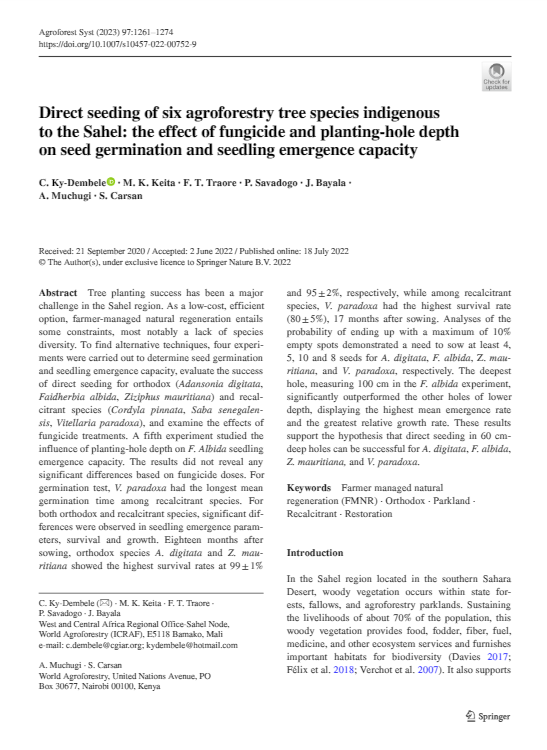Back to Library
Direct seeding of six agroforestry tree species indigenous to the Sahel: the effect of fungicide and planting-hole depth on seed germination and seedling emergence capacity

Published by:
Online Location
https://www.cifor-icraf.org/knowledge/publication/35323/
Publication date
18/07/2022
Language:
English
Type of Publication:
Studies
Focus Region:
Sub-Saharan Africa
Focus Topic:
Agricultural Value Chains / Agri-Businesses
Climate / Weather / Environment
Author
Ky-Dembele, C.; Keita, M.K.; Traore, F.T.; Savadogo, P.; Bayala, J.; Muchugi, A.; Carsan, S.
Tree planting success has been a major challenge in the Sahel region. As a low-cost, efficient option, farmer-managed natural regeneration entails some constraints, most notably a lack of species diversity. To find alternative techniques, four experiments were carried out to determine seed germination and seedling emergence capacity, evaluate the success of direct seeding for orthodox (Adansonia digitata, Faidherbia albida, Ziziphus mauritiana) and recalcitrant species (Cordyla pinnata, Saba senegalensis, Vitellaria paradoxa), and examine the effects of fungicide treatments. A fifth experiment studied the influence of planting-hole depth on F. Albida seedling emergence capacity. The results did not reveal any significant differences based on fungicide doses. For germination test, V. paradoxa had the longest mean germination time among recalcitrant species. For both orthodox and recalcitrant species, significant differences were observed in seedling emergence parameters, survival and growth. Eighteen months after sowing, orthodox species A. digitata and Z. mauritiana showed the highest survival rates at 99 ± 1% and 95 ± 2%, respectively, while among recalcitrant species, V. paradoxa had the highest survival rate (80 ± 5%), 17 months after sowing. Analyses of the probability of ending up with a maximum of 10% empty spots demonstrated a need to sow at least 4, 5, 10 and 8 seeds for A. digitata, F. albida, Z. mauritiana, and V. paradoxa, respectively. The deepest hole, measuring 100 cm in the F. albida experiment, significantly outperformed the other holes of lower depth, displaying the highest mean emergence rate and the greatest relative growth rate. These results support the hypothesis that direct seeding in 60 cm-deep holes can be successful for A. digitata, F. albida, Z. mauritiana, and V. paradoxa.